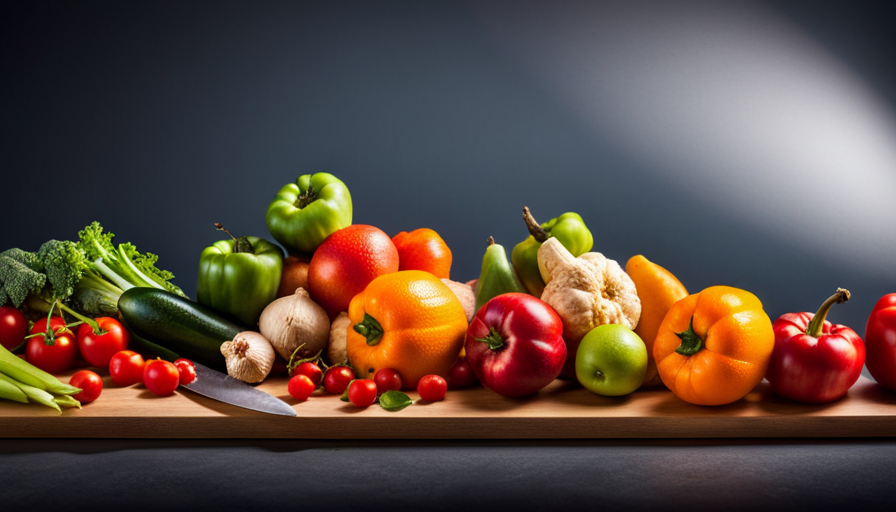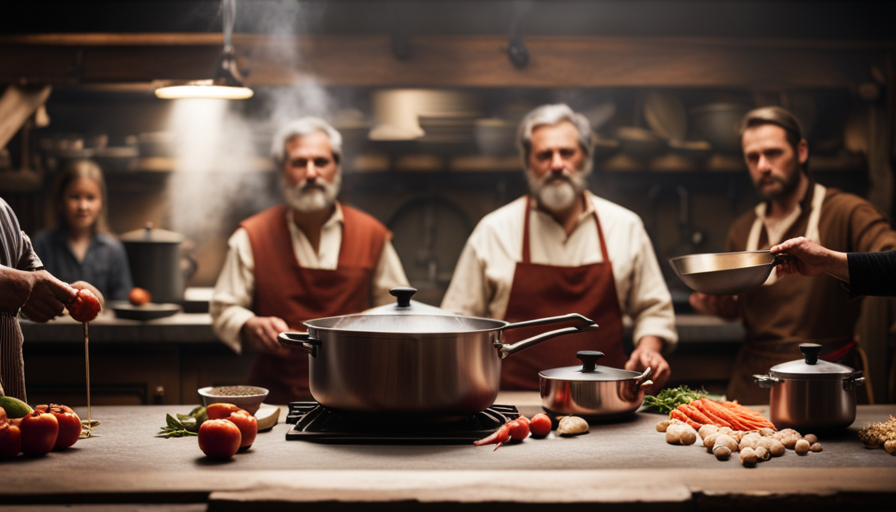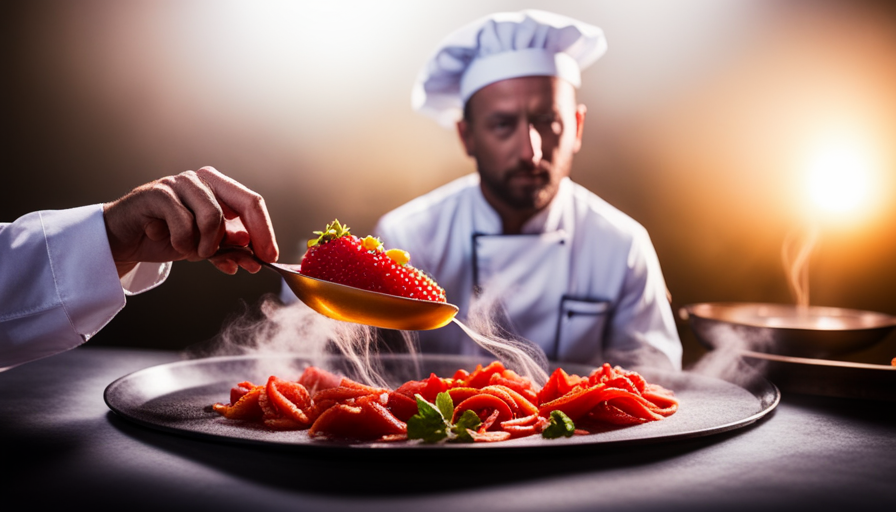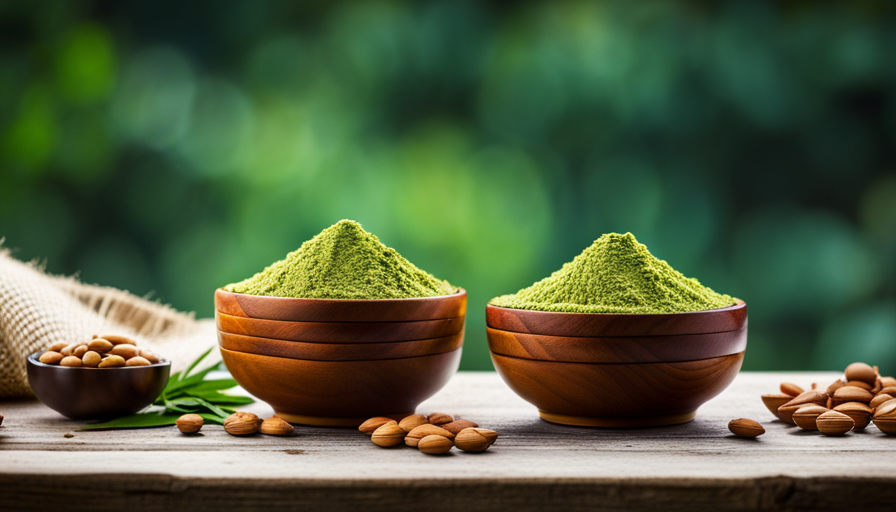Tired of the same old, heavy meals that leave you feeling tired and sluggish? Brace yourself for an amazing surprise, because we are introducing a completely new way of dining that will rejuvenate your body and tantalize your taste buds.
Welcome to the world of raw food meals, where the possibilities are endless and the benefits are abundant.
Ironically, when you think of raw food, you might envision boring salads and tasteless snacks. But let us assure you, preparing raw food meals is anything but boring. In fact, it’s a culinary adventure that will open your eyes to a whole new world of flavors, textures, and creativity.
In this article, we will guide you through the art of preparing raw food meals, from stocking your pantry with nutritious ingredients to creating flavorful salads, soups, and even desserts. We’ll provide you with essential tools, meal planning tips, and tricks for maintaining a balanced raw food diet.
So get ready to revitalize your body, nourish your soul, and enjoy the vibrant and delicious world of raw food.
Let’s get started!
Key Takeaways
- Raw food meals offer a variety of flavors and textures, making them enjoyable and satisfying.
- Raw food maximizes nutrient absorption and promotes optimal health by preserving the natural enzymes and nutrients in the ingredients.
- Raw food diets have a positive impact on the environment as they require less energy for cooking and reduce food waste.
- Incorporating raw food into your diet can have health benefits such as improved digestion, increased energy levels, and support for the immune system.
Understanding the Benefits of Raw Food
Now that you’ve learned about the incredible benefits of raw food, it’s time to dive into the delicious world of nutrient-rich meals that’ll leave you feeling energized and vibrant.
Understanding the science behind raw food is key to appreciating its many advantages. Raw food is packed with essential vitamins, minerals, and enzymes that’re often lost during the cooking process. By consuming food in its natural state, you’re able to maximize the amount of nutrients your body can absorb, promoting optimal health and well-being.
In addition to the nutritional benefits, raw food diets also have a positive impact on the environment. Traditional cooking methods often require large amounts of energy, contributing to greenhouse gas emissions and environmental degradation. Raw food meals, on the other hand, require minimal cooking or heating, reducing energy consumption and carbon footprint. By choosing raw food, you’re not only nourishing your body but also making a conscious effort to protect our planet.
Incorporating raw food into your diet doesn’t mean you have to give up all cooked food. It’s about finding a balance that works for you. Gradually increasing the amount of raw food in your meals can have significant health benefits, such as improved digestion, increased energy levels, and clearer skin. So why not give it a try? Embrace the science behind raw food and its positive impact on both your health and the environment.
Stocking Your Pantry with Raw Ingredients
To create a well-stocked pantry for preparing raw meals, it’s important to have a variety of fresh ingredients on hand. Proper pantry organization is key to ensuring that you have everything you need when it comes time to whip up a delicious raw food meal.
Start by assessing your current pantry and making sure it’s clean and free of any expired or unhealthy items. When it comes to raw food shopping, focus on buying whole, unprocessed foods. Opt for organic fruits and vegetables, as they’re free from harmful pesticides and chemicals. Leafy greens, like kale and spinach, are great staples for raw meals, as they’re packed with essential nutrients.
Nuts and seeds, such as almonds and chia seeds, are also essential for adding texture and flavor to your dishes. Additionally, stock up on raw condiments like apple cider vinegar, tamari, and raw honey to enhance the taste of your meals. Don’t forget to include a variety of spices and herbs, such as garlic, turmeric, and cilantro, to add depth and complexity to your recipes.
By organizing your pantry and shopping for raw ingredients, you’ll be well-prepared to create delicious and nutritious raw food meals that’ll leave you feeling satisfied and energized.
Essential Tools for Raw Food Preparation
Make sure you have the essential tools in your kitchen to effortlessly create mouthwatering and nutrient-packed raw dishes that’ll have you eagerly anticipating mealtime.
When it comes to raw food preparation, having the right equipment can make all the difference. Here are some must-have tools for your raw food journey.
First and foremost, a high-speed blender is essential for creating smooth and creamy sauces, soups, and smoothies. Look for a blender that’s powerful enough to handle tough ingredients like nuts and seeds.
A food processor is also a must-have tool for chopping, slicing, and shredding fruits and vegetables. It can also be used to make raw desserts and nut butters.
Investing in a good quality dehydrator is another wise choice. This handy appliance allows you to dry fruits, vegetables, and herbs, preserving their nutrients and flavors. It’s perfect for making raw crackers, granola, and even raw pizza crusts.
To make zoodles (zucchini noodles) and other vegetable pasta, a spiralizer is a must. This tool turns vegetables into fun and delicious pasta-like strands, adding a whole new dimension to your raw food dishes.
Don’t forget about a good knife set, cutting board, and a high-quality blender. These tools’ll make your raw food preparation a breeze.
Now that you have the essential tools, it’s time to start exploring the world of raw food. There are plenty of amazing recipes out there that’ll satisfy your taste buds and nourish your body. From refreshing salads to decadent desserts, the possibilities are endless. So gather your equipment, find the best raw food recipes, and get ready to embark on a delicious and nutritious culinary adventure.
Creating Flavorful Raw Salads
Get ready to tantalize your taste buds with a variety of vibrant and refreshing raw salads that burst with flavor and nourishing ingredients. When it comes to creating flavorful raw salads, the dressing options and toppings you choose can make all the difference.
To start, let’s explore some flavorful dressing options that will elevate your raw salads to the next level. Try making a zesty lemon-garlic dressing by whisking together fresh lemon juice, minced garlic, extra-virgin olive oil, and a pinch of sea salt. Or, for a creamy and tangy dressing, blend together ripe avocado, apple cider vinegar, fresh herbs, and a splash of water until smooth. These dressings will add a burst of flavor and moisture to your raw salads.
Next, let’s talk about creative raw salad toppings. Adding toppings not only enhances the taste of your salad but also adds texture and visual appeal. Consider adding crunchy nuts and seeds like almonds, sunflower seeds, or hemp hearts for a dose of healthy fats and protein. Fresh herbs like basil, cilantro, or mint can provide a burst of freshness. And don’t forget about the sweetness of dried fruits like cranberries or raisins, which can balance out the flavors in your salad.
To provide a visual representation of these flavorful dressing options and creative raw salad toppings, here is a table highlighting some delicious combinations:
| Dressing Options | Salad Toppings |
|---|---|
| Zesty Lemon-Garlic | Crunchy Almonds |
| Creamy Avocado | Fresh Basil |
| Tangy Apple Cider | Sweet Cranberries |
| Herby Green Goddess | Nutty Hemp Hearts |
By experimenting with different dressing options and toppings, you can create endless combinations of flavorful raw salads that will satisfy your taste buds and provide nourishment for your body. So go ahead, get creative, and enjoy the vibrant flavors of raw salads.
Exploring Raw Soups and Gazpachos
If you’re looking to experience a flavor explosion like no other, then brace yourself for the mind-blowing world of raw soups and gazpachos. Exploring raw soup recipes can open up a whole new dimension of taste and nutrition in your raw food journey.
Raw soups are not only delicious but also packed with vitamins, minerals, and enzymes that are beneficial for your overall health.
One of the benefits of incorporating gazpachos into your diet is that they’re a great source of hydration. Made primarily with fresh vegetables and herbs, gazpachos are packed with water content, helping to keep you hydrated while enjoying a refreshing and flavorful meal.
Additionally, raw soups are easy to digest, allowing your body to absorb the nutrients more efficiently.
When exploring raw soup recipes, you’ll find an endless variety of flavors and combinations to experiment with. From classic tomato gazpachos to creamy avocado soups, the possibilities are endless. You can also add in other raw ingredients like cucumber, bell peppers, and fresh herbs to enhance the taste and nutritional profile.
To prepare raw soups and gazpachos, simply blend all the ingredients together until smooth and creamy. You can serve them chilled or at room temperature, depending on your preference.
So, why not dive into the world of raw soups and gazpachos and discover a whole new level of flavor and health benefits?
Making Nutritious Raw Smoothies and Juices
Now that you’ve learned all about exploring raw soups and gazpachos, it’s time to dive into the world of nutritious raw smoothies and juices. These refreshing beverages aren’t just delicious, but they also provide a plethora of health benefits.
Raw food smoothie recipes are a fantastic way to incorporate a wide variety of fruits, vegetables, and other nutritious ingredients into your diet. From green smoothies packed with leafy greens like spinach and kale to fruity smoothies bursting with antioxidant-rich berries, the options are endless. These smoothies aren’t just a convenient way to consume your daily dose of vitamins and minerals, but also a great way to increase your intake of fiber and hydration.
On the other hand, juicing is another popular method of preparing raw foods. By extracting the juice from fruits and vegetables, you can concentrate their nutrients into a concentrated and easily digestible form. Juicing allows you to consume a larger quantity of produce in one sitting, providing a quick and efficient way to nourish your body.
The benefits of juicing are numerous. It can help boost your immune system, improve digestion, and increase your energy levels. Additionally, juicing is an excellent way to cleanse and detoxify your body, as it helps to eliminate toxins and supports liver function.
Incorporating raw smoothies and juices into your diet is a simple and effective way to enhance your overall well-being. So why not grab your blender or juicer and start experimenting with these nutritious recipes today? Your body will thank you!
Raw Desserts: Sweet Treats without the Guilt
Indulge in guilt-free sweet treats with raw desserts, satisfying your cravings while nourishing your body. Raw desserts are a fantastic way to enjoy a guilt-free indulgence without compromising your health goals. By using raw, unprocessed ingredients, you can create delicious desserts that are packed with nutrients and flavor.
One popular type of raw dessert is raw chocolate recipes. These recipes use raw cacao powder, which is rich in antioxidants and minerals. You can create mouthwatering chocolate treats like raw chocolate truffles or raw chocolate mousse. These desserts not only taste amazing but also provide you with the benefits of raw cacao, such as improved mood and enhanced heart health.
To help you navigate the world of raw desserts, here is a table that showcases five delicious raw chocolate recipes:
| Recipe | Ingredients | Preparation Time |
|---|---|---|
| Raw Chocolate Bars | Raw cacao powder, nuts, dates, coconut oil | 15 minutes |
| Raw Chocolate Cake | Almonds, dates, raw cacao powder, coconut oil | 30 minutes |
| Raw Chocolate Balls | Cashews, dates, raw cacao powder, shredded coconut | 20 minutes |
| Raw Chocolate Pudding | Avocado, raw cacao powder, maple syrup, almond milk | 10 minutes |
| Raw Chocolate Brownies | Walnuts, dates, raw cacao powder, vanilla extract | 25 minutes |
These recipes are simple to make and require minimal preparation time. So go ahead and satisfy your sweet tooth with guilt-free raw desserts!
Incorporating Raw Snacks into Your Routine
Incorporating raw snacks into your routine can be a simple and delicious way to increase your nutrient intake throughout the day. Studies have shown that individuals who consume raw snacks regularly have reported higher energy levels and improved digestion, so why not give it a try?
Raw snack recipes are abundant and easy to make. From simple fruit and vegetable slices to more elaborate creations like energy balls and raw granola bars, there’s something for everyone. These snacks are packed with vitamins, minerals, and enzymes that can support your overall health and well-being.
The benefits of incorporating raw snacks into your diet are numerous. Raw snacks are often low in calories and high in fiber, making them a great choice for weight management. They can also help curb cravings for unhealthy processed snacks by providing a satisfying crunch and natural sweetness.
In addition to their nutritional benefits, raw snacks can also be a convenient option for busy individuals. They can be prepared in advance and easily packed for on-the-go snacking. So whether you’re at work, on a hike, or simply running errands, raw snacks can keep you fueled and satisfied throughout the day.
Incorporating raw snacks into your routine is a simple and effective way to boost your nutrient intake. With a wide variety of recipes to choose from, the benefits of raw snacks are clear, so why not give them a try and experience the improved energy and digestion that many others have reported?
Raw Food Meal Planning and Batch Prepping
Planning and batch prepping your meals with raw ingredients can save you time and ensure that you have nutritious options readily available. Meal prepping is an effective strategy that allows you to plan and prepare your meals in advance, so you don’t have to worry about what to eat during busy days. When it comes to raw food meal prepping, there are plenty of recipe ideas that you can try.
To help you get started, here is a table with five recipe ideas for raw food meal prepping:
| Recipe Ideas | Ingredients |
|---|---|
| Raw Veggie Wraps | Collard greens, bell peppers, carrots, hummus |
| Zucchini Noodles | Zucchini, cherry tomatoes, basil, pine nuts |
| Raw Pad Thai | Spiralized zucchini, bean sprouts, peanuts, lime |
| Raw Energy Balls | Dates, nuts, coconut, cacao powder |
| Raw Veggie Sushi | Nori sheets, avocado, cucumber, bell peppers |
These recipes are not only delicious but also packed with nutrients. You can easily prepare these meals in advance and store them in airtight containers in the refrigerator. This way, you can grab a healthy and satisfying meal whenever you need it. Remember to experiment with different flavor combinations and adjust the recipes to suit your taste preferences. Happy meal prepping!
Tips for Maintaining a Balanced Raw Food Diet
Nourishing your body with a balanced raw food diet is like tending to a delicate garden, carefully cultivating a variety of vibrant fruits, vegetables, and nuts to create a harmonious and nourishing ecosystem within yourself.
However, maintaining motivation and dealing with social situations can sometimes be challenging. Here are some tips to help you stay on track and navigate these situations:
-
Find your motivation: Remind yourself of the reasons why you chose to follow a raw food diet. Whether it’s for health reasons, ethical beliefs, or personal goals, keep your motivation at the forefront of your mind.
-
Seek support: Surround yourself with like-minded individuals who share your passion for raw food. Join online communities, attend raw food events, or find a raw food buddy who can support and motivate you.
-
Plan ahead for social situations: When attending social gatherings or dining out with friends, it’s important to plan ahead. Research raw food-friendly restaurants in your area or offer to bring a raw dish to share. Communicate your dietary preferences with friends and family in advance, so they can be accommodating.
Remember, maintaining a balanced raw food diet is a journey, and it’s normal to face challenges along the way. Stay focused on your goals, seek support, and plan ahead to ensure you can enjoy the benefits of a raw food lifestyle while navigating social situations with ease.
Frequently Asked Questions
Can you use frozen fruits and vegetables in raw food meals?
Yes, you can absolutely use frozen fruits and vegetables in raw food meals. There are several benefits to using frozen produce. Firstly, frozen fruits and vegetables are picked at peak ripeness and immediately frozen, which helps to lock in their nutrients. Secondly, they’re convenient and easily accessible year-round. To incorporate frozen produce into your raw food recipes, simply thaw them before using, or blend them into smoothies. Remember to choose organic frozen options whenever possible.
How do you properly store raw food ingredients?
To properly store raw food ingredients and maintain their freshness, follow these tips.
Firstly, keep perishable items like meat and seafood in the refrigerator at temperatures below 40°F (4°C). Use airtight containers or resealable bags to prevent cross-contamination and maintain flavor.
Additionally, store fruits and vegetables in the refrigerator’s crisper drawer to maintain their crispness and extend their shelf life.
Lastly, label and date all containers for easy tracking of expiration dates.
These proper storage techniques will ensure the safety and quality of your raw food ingredients.
Is it necessary to soak nuts and seeds before using them in raw recipes?
Soaking nuts and seeds before using them in raw recipes isn’t necessary, but it can provide some benefits. Soaking helps remove enzyme inhibitors, making them easier to digest and increasing nutrient availability. However, if you prefer not to soak, there are alternative options. You can purchase pre-soaked nuts and seeds or simply enjoy them as is. It ultimately comes down to personal preference and your digestive tolerance.
Are there any specific food safety guidelines to follow when preparing raw food meals?
To ensure food safety when preparing raw food meals, it’s important to follow specific guidelines. Foodborne illnesses can be a concern, so it’s crucial to handle raw foods properly.
- Wash your hands thoroughly before and after handling raw ingredients.nn2. Keep different types of foods separate to prevent cross-contamination.nn3. Ensure that all utensils and surfaces are clean and sanitized.
These precautions are essential, especially considering the potential benefits of a raw food diet.
Can you use a regular blender or food processor for making raw smoothies and juices?
Sure, you can use a regular blender or food processor for making raw smoothies and juices. However, if you want to take your blending game to the next level, consider investing in a high-speed blender like a Vitamix or a Ninja. These blenders are specifically designed to handle tough ingredients like frozen fruits and vegetables, resulting in smoother and creamier smoothies.
The benefits of raw smoothies include increased nutrient absorption and improved digestion. So, blend away and enjoy the health benefits!
What Are Some Raw Food Meal Preparation Techniques to Help Keep the Food Fresh Longer?
When it comes to keeping raw food fresh longer, there are a few meal preparation techniques that can help. Using airtight containers, vacuum sealing, and proper storage in the refrigerator can all contribute to maintaining the freshness of raw ingredients. Additionally, utilizing dehydrating and fermenting methods can also extend the shelf life of foods.
Conclusion
In conclusion, preparing raw food meals can be a delicious and nutritious way to enhance your overall health and well-being. While some may argue that it takes too much time and effort, the benefits far outweigh any inconvenience.
By stocking your pantry with raw ingredients and using essential tools, you can easily create flavorful salads, soups, desserts, and snacks. With proper meal planning and batch prepping, you can stay on track with a balanced raw food diet.
Don’t let the fear of a time commitment hold you back from experiencing the countless benefits of raw food meals. Give it a try and see the positive impact it can have on your health.










